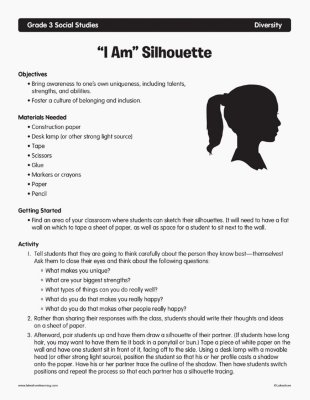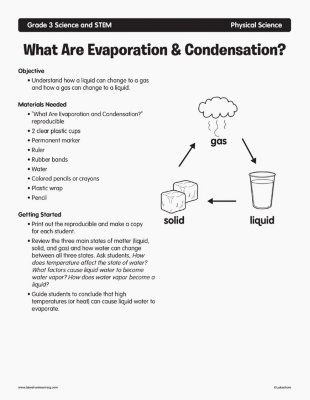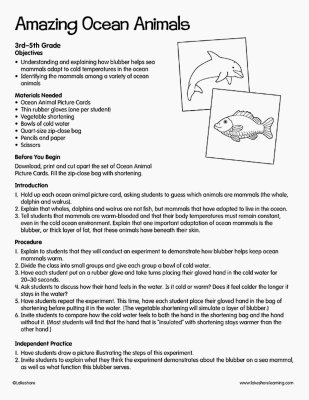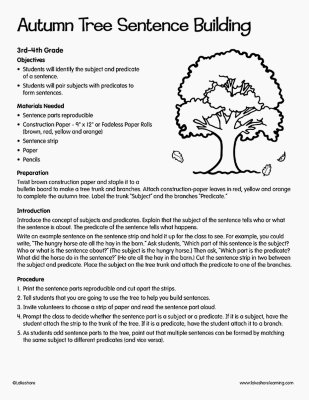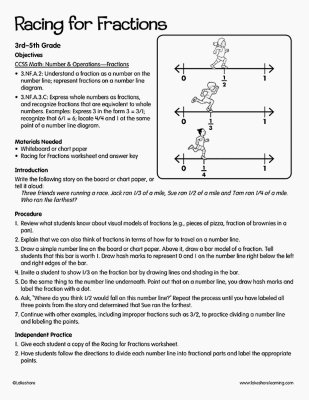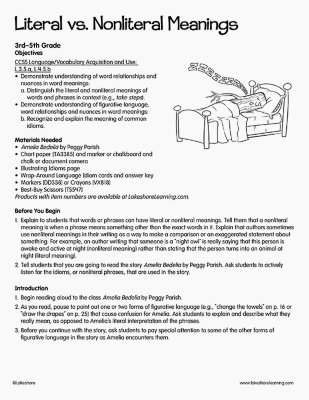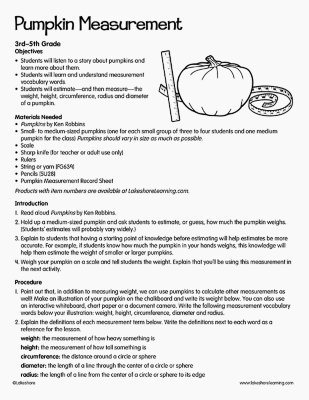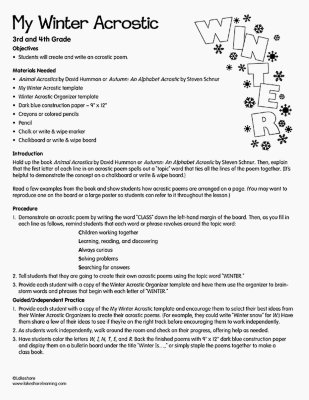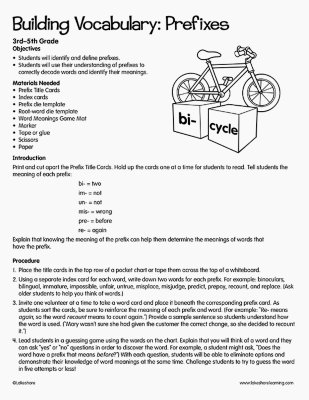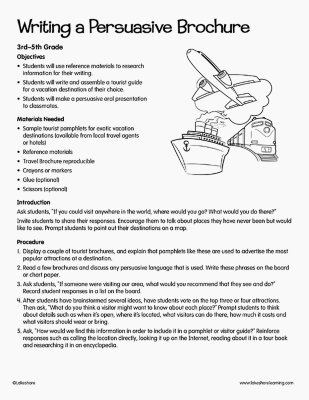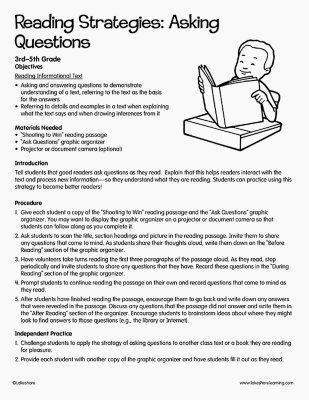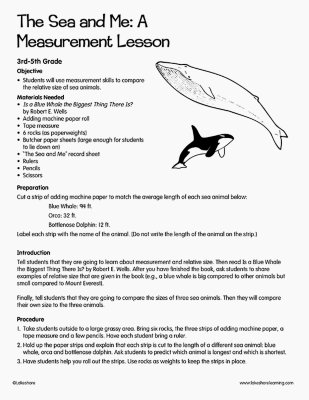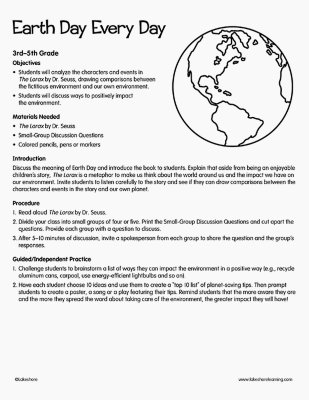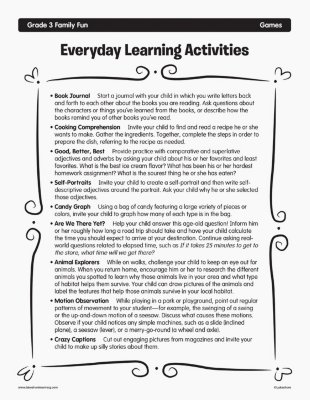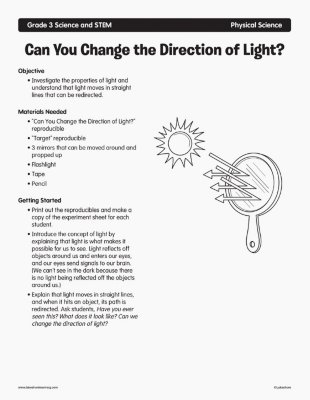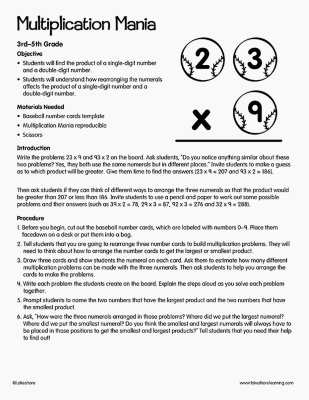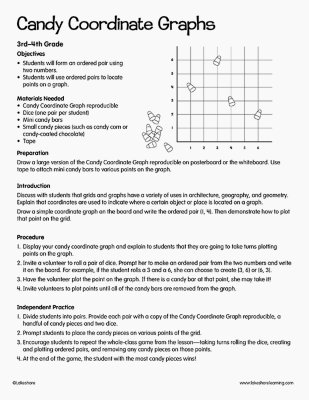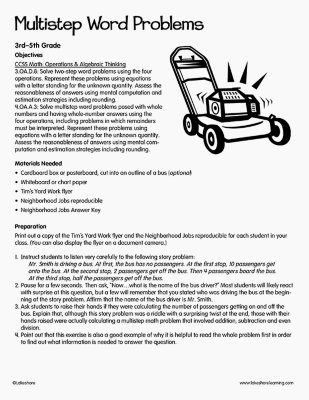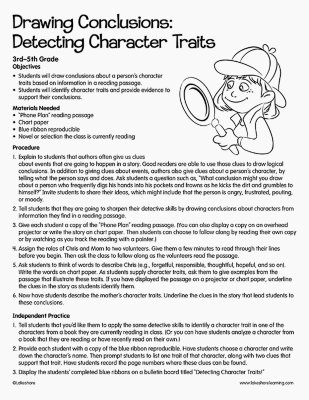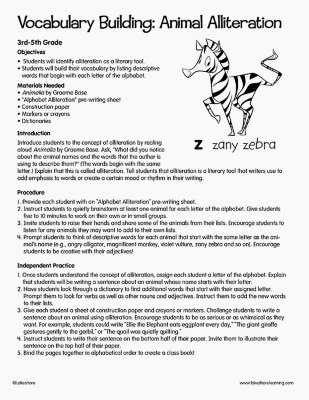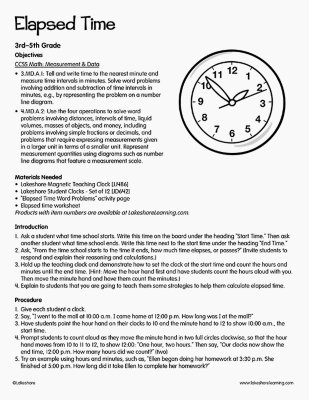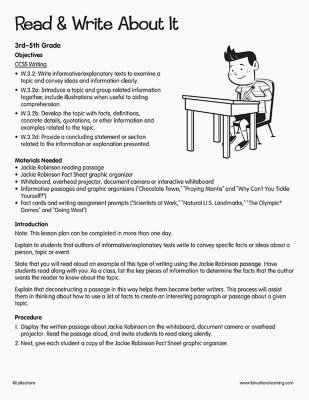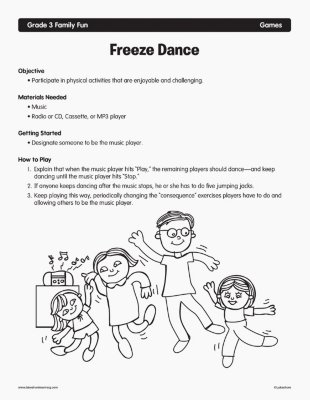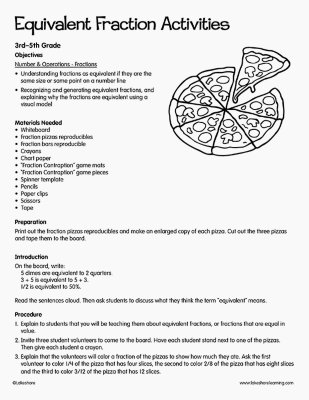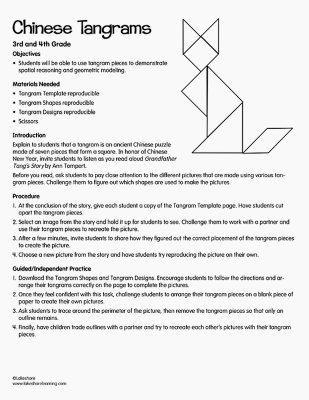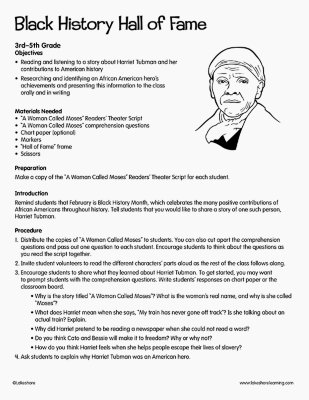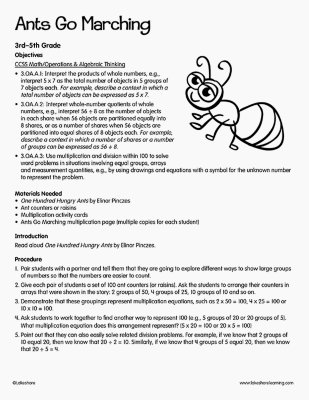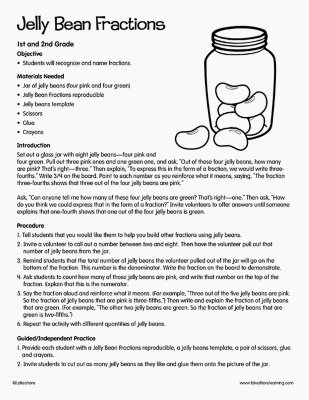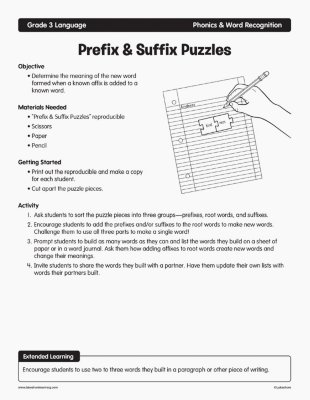Narrow by Grade
- Infant (10)
- Toddler (11)
- Preschool (0)
- Pre-K (22)
- Kindergarten (26)
- 1st (37)
- 2nd (33)
- 3rd (33)
- 4th (27)
- 5th (13)
- 6th & Up (0)
Grade 3rd
Narrow by Age
- 0-18m (0)
- 18-36m (0)
- 3 yrs. (0)
- 4 yrs. (0)
- 5 yrs. (0)
- 6 yrs. (0)
- 7 yrs. (0)
- 8 yrs. (33)
- 9 yrs. (15)
- 10 yrs. (5)
- 11 yrs. & Up (0)
Age
0 results for "art" , here are results for "are"
ITEMS:
Filters
Clear All
"I Am" Silhouette
3rd Grade
Objectives
- Bring awareness to one’s own uniqueness, including talents, strengths, and abilities.
- Foster a culture of belonging and inclusion.
What Are Evaporation & Condensation?Understand how a liquid can change to a gas and how a gas can change to a liquid.
3rd Grade
Objective
Amazing Ocean Animals
3rd Grade
Objectives Understanding and explaining how blubber helps sea mammals adapt to cold temperatures in the ocean Identifying the mammals among a variety of ocean animals Materials Needed Ocean Animal Picture Cards Thin rubber gloves (one per student) Vegetable shortening Bowls of cold water Quart-size zip-close bag Pencils and paper Scissors Before You Begin Download, print and cut apart the set of Ocean Animal Picture Cards. Fill the zip-close bag with shortening. Introduction Hold up each ocean animal picture card, asking students to guess which animals are mammals (the whale, dolphin and walrus). Explain that whales, dolphins and walrus are not fish, but mammals that have adapted to live in the ocean. Tell students that mammals are warm-blooded and that their body temperatures must remain constant, even in the cold ocean environment. Explain that one important adaptation of ocean mammals is the blubber, or thick layer of fat, that these animals have beneath their skin.
View Lesson PlanAutumn Tree Sentence Building
3rd Grade - 4th Grade
Objectives Students will identify the subject and predicate of a sentence. Students will pair subjects with predicates to form sentences. Materials Needed Sentence parts reproducible Construction Paper - 9" x 12" or Fadeless Paper Rolls (brown, red, yellow and orange) Sentence strip Paper Pencils Preparation: Twist brown construction paper and staple it to a bulletin board to make a tree trunk and branches. Attach construction-paper leaves in red, yellow and orange to complete the autumn tree. Label the trunk “Subject” and the branches “Predicate.” Introduction Introduce the concept of subjects and predicates. Explain that the subject of the sentence tells who or what the sentence is about. The predicate of the sentence tells what happens. Write an example sentence on the sentence strip and hold it up for the class to see. For example, you could write, “The hungry horse ate all the hay in the barn.” Ask students, “Which part of this sentence is the subject? Who or what is the sentence about?” (The subject is the hungry horse.) Then ask, “Which part is the predicate? What did the horse do in the sentence?” (He ate all the hay in the barn.) Cut the sentence strip in two between the subject and predicate. Place the subject on the tree trunk and attach the predicate to one of the branches.
View Lesson PlanRacing for Fractions
3rd Grade
Objectives CCSS Math: Number & Operations—Fractions 3.NF.A.2: Understand a fraction as a number on the number line; represent fractions on a number line diagram. 3.NF.A.3.C: Express whole numbers as fractions, and recognize fractions that are equivalent to whole numbers. Examples: Express 3 in the form 3 = 3/1; recognize that 6/1 = 6; locate 4/4 and 1 at the same point of a number line diagram. Materials Needed Whiteboard or chart paper Racing for Fractions worksheet and answer key Introduction Write the following story on the board or chart paper, or tell it aloud: Three friends were running a race. Jack ran 1/3 of a mile, Sue ran 1/2 of a mile and Tam ran 1/4 of a mile. Who ran the farthest?
View Lesson PlanLiteral vs. Nonliteral Meanings
3rd Grade - 4th Grade
Objective CCSS Language/Vocabulary Acquisition and Use: L.3.5.a, L.4.5.b Demonstrate understanding of word relationships and nuances in word meanings: a. Distinguish the literal and nonliteral meanings of words and phrases in context (e.g., take steps). Demonstrate understanding of figurative language, word relationships and nuances in word meanings: b. Recognize and explain the meaning of common idioms. Materials Needed Amelia Bedelia by Peggy Parish Chart paper and marker or chalkboard and chalk or document camera Illustrating Idioms page Wrap-Around Language Idiom cards and answer key Markers or Crayons Best-Buy Scissors Before You Begin Explain to students that words or phrases can have literal or nonliteral meanings. Tell them that a nonliteral meaning is when a phrase means something other than the exact words in it. Explain that authors sometimes use nonliteral meanings in their writing as a way to make a comparison or an exaggerated statement about something. For example, an author writing that someone is a “night owl” is really saying that this person is awake and active at night (nonliteral meaning) rather than stating that the person turns into an animal at night (literal meaning). Tell students that you are going to read the story Amelia Bedelia by Peggy Parish. Ask students to actively listen for the idioms, or nonliteral phrases, that are used in the story. Introduction Begin reading aloud to the class Amelia Bedelia by Peggy Parish. As you read, pause to point out one or two forms of figurative language (e.g., “change the towels” on p. 16 or “draw the drapes” on p. 25) that cause confusion for Amelia. Ask students to explain and describe what they really mean, as opposed to Amelia’s literal interpretation of the phrases. Before you continue with the story, ask students to pay special attention to some of the other forms of figurative language in the story as Amelia encounters them.
View Lesson PlanMenu Math
3rd Grade - 4th Grade
Objectives CCSS Math: Operations & Algebraic Thinking 3.OA.D.8: Solve two-step word problems using the four operations. Represent these problems using equations with a letter standing for the unknown quantity. Assess the reasonableness of answers using mental computation and estimation strategies including rounding. 4.OA.A.3: Solve multistep word problems posed with whole numbers and having whole-number answers using the four operations, including problems in which remainders must be
View Lesson PlanPumpkin Measurement
3rd Grade
Objectives Students will listen to a story about pumpkins and learn more about them. Students will learn and understand measurement vocabulary words. Students will estimate—and then measure—the weight, height, circumference, radius and diameter of a pumpkin. Materials Needed Pumpkins by Ken Robbins Small- to medium-sized pumpkins (one for each small group of three to four students and one medium pumpkin for the class) Pumpkins should vary in size as much as possible. Scale Sharp knife (for teacher or adult use only) Rulers String or yarn Pencils Pumpkin Measurement Record Sheet Introduction Read aloud Pumpkins by Ken Robbins. Hold up a medium-sized pumpkin and ask students to estimate, or guess, how much the pumpkin weighs. (Students’ estimates will probably vary widely.) Explain to students that having a starting point of knowledge before estimating will help estimates be more accurate. For example, if students know how much the pumpkin in your hands weighs, this knowledge will help them estimate the weight of smaller or larger pumpkins. Weigh your pumpkin on a scale and tell students the weight. Explain that you’ll be using this measurement in the next activity.
View Lesson PlanMy Winter Acrostic
3rd Grade - 5th Grade
Objectives Reading: Literature Reading and comprehending grade-appropriate literature, including stories, dramas, and poetry Writing Writing an acrostic poem Materials Needed Animal Acrostics by David Hummon or Autumn: An Alphabet Acrostic by Steven Schnur My Winter Acrostic template Winter Acrostic Organizer template Dark-blue construction paper - 9" x 12" Crayons or colored pencils Pencil Chalk or write & wipe marker Chalkboard or write & wipe board Introduction Hold up the book Animal Acrostics by David Hummon or Autumn: An Alphabet Acrostic by Steven Schnur. Then explain that the first letter of each line in an acrostic poem spells out a “topic” word that ties all the lines of the poem together. (It’s helpful to demonstrate the concept on a chalkboard or write & wipe board.) Read a few examples from the book and show students how acrostic poems are arranged on a page. (You may want to reproduce one on the board or a large poster so students can refer to it throughout the lesson.)
View Lesson PlanBuilding Vocabulary: Prefixes
3rd Grade - 4th Grade
Objectives Identifying and knowing the meaning of the most common prefixes and derivational suffixes Determining the meaning of the new word formed when a known affix is added to a known word Using common, grade-appropriate Greek and Latin affixes and roots as clues to the meaning of a word Materials Needed Prefix title cards Index cards Prefix die template Root-word die template Word meanings game mat Marker Tape or glue Scissors Paper Pocket chart or whiteboard Introduction Print and cut apart the prefix title cards. Hold up the cards one at a time for students to read. Tell students the meaning of each prefix: bi- = two im- = not un- = not mis- = wrong pre- = before re- = again Explain that knowing the meaning of the prefix can help them determine the meanings of words that have the prefix.
View Lesson PlanWriting a Persuasive Brochure
3rd Grade - 5th Grade
Objectives Using reference materials to research for their writing Introducing the topic or text they are writing about, stating an opinion and creating an organizational structure that lists reasons Providing reasons that support the opinion Reporting on a topic or text, telling a story, or recounting an experience in an organized manner, using appropriate facts and relevant, descriptive details to support main ideas or themes; speaking clearly at an understandable pace Materials Needed Sample tourist pamphlets for exotic vacation destinations (available from local travel agents or hotels) Reference materials Travel Brochure reproducible Crayons or markers Glue (optional) Scissors (optional) Introduction Ask students, “If you could visit anywhere in the world, where would you go? What would you do there?” Invite students to share their responses. Encourage them to talk about places they have never been but would like to see. Prompt students to point out their destinations on a map.
View Lesson PlanReading Strategies: Asking Questions
3rd Grade - 4th Grade
Objectives Reading Informational Text Asking and answering questions to demonstrate understanding of a text, referring to the text as the basis for the answers Referring to details and examples in a text when explaining what the text says and when drawing inferences from it Materials Needed “Shooting to Win” reading passage “Ask Questions” graphic organizer Projector or document camera (optional) Introduction Tell students that good readers ask questions as they read. Explain that this helps readers interact with the text and process new information—so they understand what they are reading. Students can practice using this strategy to become better readers!
View Lesson PlanThe Sea and Me: A Measurement Lesson
3rd Grade
Objective Students will use measurement skills to compare the relative size of sea animals. Materials Needed Is a Blue Whale the Biggest Thing There Is? by Robert E. Wells Adding machine paper roll Tape measure 6 rocks (as paperweights) Butcher paper sheets (large enough for students to lie down on) “The Sea and Me” Record Sheet Rulers Pencils Scissors Preparation: Cut a strip of adding machine paper to match the average length of each sea animal below: Blue Whale: 94 ft. Orca: 32 ft. Bottlenose Dolphin: 12 ft. Label each strip with the name of the animal. (Do not write the length of the animal on the strip.) Introduction Tell students that they are going to learn about measurement and relative size. Then read Is a Blue Whale the Biggest Thing There Is? by Robert E. Wells. After you have finished the book, ask students to share examples of relative size that are given in the book (e.g., a blue whale is big compared to other animals but small compared to Mount Everest). Finally, tell students that they are going to compare the sizes of three sea animals. Then they will compare their own size to the three animals.
View Lesson PlanEarth Day Every Day
3rd Grade - 5th Grade
Objectives Students will analyze the characters and events in The Lorax by Dr. Seuss, drawing comparisons between the fictitious environment and our own environment. Students will discuss ways to positively impact the environment. Materials Needed The Lorax by Dr. Seuss Small-Group Discussion Questions Colored pencils, pens or markers Introduction Discuss the meaning of Earth Day, and introduce the book to students. Explain that aside from being an enjoyable children’s story, The Lorax is a metaphor to make us think about the world around us and the impact we have on our environment. Invite students to listen carefully to the story and see if they can draw comparisons between the characters and events in the story and our own planet.
View Lesson PlanEveryday Learning Activities
3rd Grade
Book Journal Start a journal with your child in which you write letters back and forth to each other about the books you are reading. Ask questions about the characters or things you’ve learned from the books, or describe how the books remind you of other books you’ve read.
View Lesson PlanCan You Change the Direction of Light?
3rd Grade
Objective
- Investigate the properties of light and understand that light moves in straight lines that can be redirected.
Multiplication Mania
3rd Grade
Objectives Students will find the product of a single-digit number and a double-digit number. Students will understand how rearranging the numerals affects the product of a single-digit number and a double-digit number. Materials Needed Baseball number cards template Multiplication Mania reproducible Scissors Introduction Write the problems 23 x 9 and 93 x 2 on the board. Ask students, “Do you notice anything similar about these two problems? Yes, they both use the same numerals but in different places.” Invite students to make a guess as to which product will be greater. Give them time to find the answers (23 x 9 = 207 and 93 x 2 = 186). Then ask students if they can think of different ways to arrange the three numerals so that the product would be greater than 207 or less than 186. Invite students to use a pencil and paper to work out some possible problems and their answers (such as 39 x 2 = 78, 29 x 3 = 87, 92 x 3 = 276 and 32 x 9 = 288).
View Lesson PlanCandy Coordinate Graphs
3rd Grade
Objectives Students will form an ordered pair using two numbers. Students will use ordered pairs to locate points on a graph. Materials Needed Candy Coordinate Graph reproducible Dice (one pair per student) Mini candy bars Small candy pieces (such as candy corn or candy-coated chocolate) Tape Preparation: Draw a large version of the Candy Coordinate Graph reproducible on posterboard or the whiteboard. Use tape to attach mini candy bars to various points on the graph. Introduction Discuss with students that grids and graphs have a variety of uses in architecture, geography, and geometry. Explain that coordinates are used to indicate where a certain object or place is located on a graph. Draw a simple coordinate graph on the board and write the ordered pair (1, 4). Then demonstrate how to plot that point on the grid.
View Lesson PlanMultistep Word Problems
3rd Grade
Objectives CCSS Math: Operations & Algebraic Thinking 3.OA.D.8: Solve two-step word problems using the four operations. Represent these problems using equations with a letter standing for the unknown quantity. Assess the reasonableness of answers using mental computation and estimation strategies including rounding. 4.OA.A.3: Solve multistep word problems posed with whole numbers and having whole-number answers using the four operations, including problems in which remainders must be interpreted. Represent these problems using equations with a letter standing for the unknown quantity. Assess the reasonableness of answers using mental computation and estimation strategies including rounding. Materials Needed Cardboard box or posterboard, cut into an outline of a bus (optional) Whiteboard or chart paper Tim’s Yard Work flyer Neighborhood Jobs reproducible Neighborhood Jobs Answer Key Preparation Print out a copy of the Tim’s Yard Work flyer and the Neighborhood Jobs reproducible for each student in your class. (You can also display the flyer on a document camera.) Introduction Instruct students to listen very carefully to the following story problem: Mr. Smith is driving a bus. At first, the bus has no passengers. At the first stop, 10 passengers get onto the bus. At the second stop, 2 passengers get off the bus. Then 4 passengers board the bus. At the third stop, half the passengers get off the bus. Pause for a few seconds. Then ask, “Now...what is the name of the bus driver?” Most students will likely react with surprise at this question, but a few will remember that you stated who was driving the bus at the beginning of the story problem. Affirm that the name of the bus driver is Mr. Smith. Ask students to raise their hands if they were calculating the number of passengers getting on and off the bus. Explain that, although this story problem was a riddle with a surprising twist at the end, those with their hands raised were actually calculating a multistep math problem that involved addition, subtraction and even division. Point out that this exercise is also a good example of why it is helpful to read the whole problem first in order to find out what information is needed to answer the question.
View Lesson PlanDrawing Conclusions: Detecting Character Traits
3rd Grade - 4th Grade
Objectives Students will draw conclusions about a person’s character traits based on information in a reading passage. Students will identify character traits and provide evidence to support their conclusions. Materials Needed “Phone Plan” reading passage Chart paper Blue ribbon reproducible Novel or selection the class is currently reading
View Lesson PlanVocabulary Building: Animal Alliteration
3rd Grade - 4th Grade
Objectives Students will identify alliteration as a literary tool. Students will build their vocabulary by listing descriptive words that begin with each letter of the alphabet. Materials Needed Animalia by Graeme Base “Alphabet Alliteration” pre-writing sheet Construction paper Markers or crayons Dictionaries Introduction Introduce students to the concept of alliteration by realing aloud Animalia by Graeme Base. Ask, “What did you notice about the animal names and the words that the author is using to describe them?” (The words begin with the same letter.) Explain that this is called alliteration. Tell students that alliteration is a literary tool that writers use to add emphasis to words or create a certain mood or rhythm in their writing.
View Lesson PlanElapsed Time
3rd Grade - 4th Grade
Objectives CCSS Math: Measurement & Data 3.MD.A.1: Tell and write time to the nearest minute and measure time intervals in minutes. Solve word problems involving addition and subtraction of time intervals in minutes, e.g., by representing the problem on a number line diagram. 4.MD.A.2: Use the four operations to solve word problems involving distances, intervals of time, liquid volumes, masses of objects, and money, including problems involving simple fractions or decimals, and problems that require expressing measurements given in a larger unit in terms of a smaller unit. Represent measurement quantities using diagrams such as number line diagrams that feature a measurement scale. Materials Needed Lakeshore Magnetic Teaching Clock Lakeshore Student Clocks - Set of 12 “Elapsed Time Word Problems” activity page Elapsed time worksheet Introduction Ask a student what time school starts. Write this time on the board under the heading “Start Time.” Then ask another student what time school ends. Write this time next to the start time under the heading “End Time.” Ask, “From the time school starts to the time it ends, how much time elapses, or passes?” (Invite students to respond and explain their reasoning and calculations.) Hold up the teaching clock and demonstrate how to set the clock at the start time and count the hours and minutes until the end time. (Hint: Move the hour hand first and have students count the hours aloud with you. Then move the minute hand and have them count the minutes.) Explain to students that you are going to teach them some strategies to help them calculate elapsed time.
View Lesson PlanOne Heart
3rd Grade
Objectives
- Understand that people are more alike than they are different.
- Celebrate and embrace people’s cultural and ethnic backgrounds.
Read & Write About It
3rd Grade - 4th Grade
Objectives CCSS Writing W.3.2: Write informative/explanatory texts to examine a topic and convey ideas and information clearly. W.3.2a: Introduce a topic and group related information together; include illustrations when useful to aiding comprehension. W.3.2b: Develop the topic with facts, definitions, concrete details, quotations, or other information and examples related to the topic. W.3.2d: Provide a concluding statement or section related to the information or explanation presented. Materials Needed Jackie Robinson reading passage Jackie Robinson Fact Sheet graphic organizer Whiteboard, overhead projector, document camera or interactive whiteboard Informative passages and graphic organizers (“Chocolate Town,” “Praying Mantis” and “Why Can’t You Tickle Yourself?”) Fact cards and writing assignment prompts (“Scientists at Work,” “Natural U.S. Landmarks,” “The Olympic® Games” and “Going West”) Introduction Note: This lesson plan can be completed in more than one day. Explain to students that authors of informative/explanatory texts write to convey specific facts or ideas about a person, topic or event. State that you will read aloud an example of this type of writing using the Jackie Robinson passage. Have students read along with you. As a class, list the key pieces of information to determine the facts that the author wants the reader to know about the topic. Explain that deconstructing a passage in this way helps them become better writers. This process will assist them in thinking about how to use a list of facts to create an interesting paragraph or passage about a given topic.
View Lesson PlanFreeze Dance
3rd Grade
Objective
- Participate in physical activities that are enjoyable and challenging.
Equivalent Fraction Activities
3rd Grade
Objectives Number & Operations - Fractions Understanding fractions as equivalent if they are the same size or same point on a number line Recognizing and generating equivalent fractions, and explaining why the fractions are equivalent using a visual model Materials Needed Whiteboard Fraction pizzas reproducibles Fraction bars reproducible Crayons Chart paper “Fraction Contraption” game mats “Fraction Contraption” game pieces Spinner template Pencils Paper clips Scissors Tape Introduction On the board, write: 5 dimes are equivalent to 2 quarters. 3 + 5 is equivalent to 5 + 3. 1/2 is equivalent to 50%. Read the sentences aloud. Then ask students to discuss what they think the term “equivalent” means.
View Lesson PlanChinese Tangrams
3rd Grade
Objective Students will be able to use tangram pieces to demonstrate spatial reasoning and geometric modeling. Materials Needed Tangram Template Reproducible Tangram Shapes Reproducible Tangram Designs Reproducible Scissors Introduction Explain to students that a tangram is an ancient Chinese puzzle made of seven pieces that form a square. In honor of Chinese New Year, invite students to listen as you read aloud Grandfather Tang’s Story by Ann Tompert. Before you read, ask students to pay close attention to the different pictures that are made using various tangram pieces. Challenge them to figure out which shapes are used to make the pictures.
View Lesson PlanBlack History Hall of Fame
3rd Grade - 5th Grade
Objectives Reading and listening to a story about Harriet Tubman and her contributions to American history Researching and identifying an African American hero’s achievements and presenting this information to the class orally and in writing Materials Needed “A Woman Called Moses” Readers’ Theater Script “A Woman Called Moses” comprehension questions Chart paper (optional) Markers “Hall of Fame” frame Scissors Preparation Make a copy of the “A Woman Called Moses” Readers’ Theater Script for each student. Introduction Remind students that February is Black History Month, which celebrates the many positive contributions of African Americans throughout history. Tell students that you would like to share a story of one such person, Harriet Tubman.
View Lesson PlanAnts Go Marching
3rd Grade
Objectives CCSS Math/Operations & Algebraic Thinking 3.OA.A.1: Interpret the products of whole numbers, e.g., interpret 5 x 7 as the total number of objects in 5 groups of 7 objects each. For example, describe a context in which a total number of objects can be expressed as 5 x 7. 3.OA.A.2: Interpret whole-number quotients of whole numbers, e.g., interpret 56 ÷ 8 as the number of objects in each share when 56 objects are partitioned equally into 8 shares, or as a number of shares when 56 objects are partitioned into equal shares of 8 objects each. For example, describe a context in which a number of shares or a number of groups can be expressed as 56 ÷ 8. 3.OA.A.3: Use multiplication and division within 100 to solve word problems in situations involving equal groups, arrays and measurement quantities, e.g., by using drawings and equations with a symbol for the unknown number to represent the problem. Materials Needed One Hundred Hungry Ants by Elinor Pinczes Ant counters or raisins Multiplication activity cards Ants Go Marching multiplication page (multiple copies for each student) Introduction Read aloud One Hundred Hungry Ants by Elinor Pinczes.
View Lesson PlanJelly Bean Fractions
3rd Grade
Objective Students will recognize and name fractions. Materials Needed Jar of jelly beans (four pink and four green) Jelly Bean Fractions reproducible Jelly beans template Scissors Glue Crayons Introduction Set out a glass jar with eight jelly beans—four pink and four green. Pull out three pink ones and one green one, and ask, “Out of these four jelly beans, how many are pink? That’s right—three.” Then explain, “To express this in the form of a fraction, we would write three-fourths.” Write 3/4 on the board. Point to each number as you reinforce what it means, saying, “The fraction three-fourths shows that three out of the four jelly beans are pink.” Ask, “Can anyone tell me how many of these four jelly beans are green? That’s right—one.” Then ask, “How do you think we could express that in the form of a fraction?” Invite volunteers to offer answers until someone explains that one-fourth shows that one out of the four jelly beans is green.
View Lesson PlanPrefix & Suffix Puzzles
3rd Grade
Objective
- Determine the meaning of the new word formed when a known affix is added to a known word.
Close Reading and Text Features
3rd Grade - 4th Grade
Objectives CCSS Reading: Informational Text RI.3.7: Use information gained from illustrations (e.g., maps, photographs) and the words in a text to demonstrate understanding of the text (e.g., where, when, why, and how key events occur). RI.4.7: Interpret information presented visually, orally, or quantitatively (e.g., in charts, graphs, diagrams, time lines, animations, or interactive elements on Web pages) and explain how the information contributes to an understanding of the text in which it appears. Materials Needed “Three Cheers for Engineers!” reading passage Paper and pencils Introduction Provide students with a copy of the “Three Cheers for Engineers!” reading passage. Tell students, “Today we are going to read a passage titled, “Three Cheers for Engineers!” One practice of good readers is that they pay close attention to the text. As we read, I want you to think about the meaning of the text, the words that are used and other features on the page that are used to help interpret the text.”
View Lesson PlanCharacter Building: Bullying
3rd Grade - 5th Grade
Objectives Students will listen and respond to literature read aloud by the teacher. Students will share interpretations of lessons in a story and learn to apply these lessons to their own lives. Materials Needed A Bad Case of Stripes by David Shannon Chalkboard, sentence strips or interactive whiteboard Notebook paper Introduction Ask students if they have a favorite food that might surprise others, like broccoli, spinach or beets! Invite volunteers to tell the class what this surprising food is. Tell students that you are going to read a story in which the main character has an odd choice for a favorite food. Ask students to pay special attention to what happens to this character, how her classmates react to her, and what she does to solve her problem. Read aloud A Bad Case of Stripes by David Shannon.
View Lesson Plan